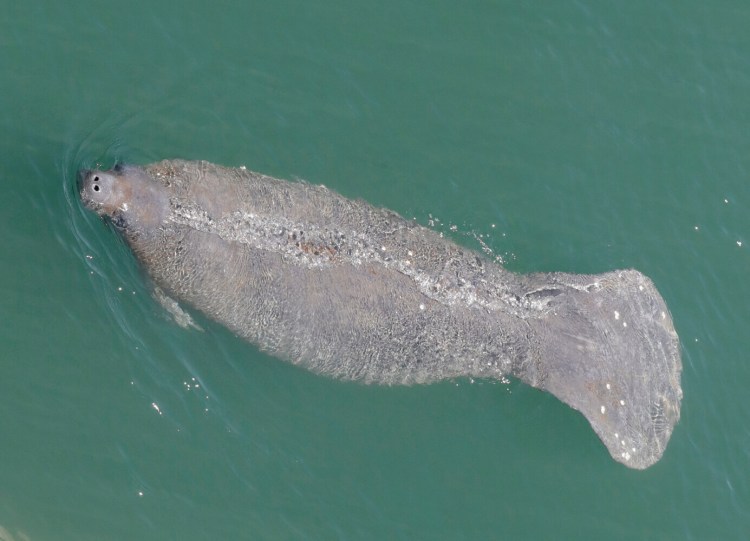WEST PALM BEACH, Fla. – A record manatee die-off in Florida this year has become so dire that federal officials are taking a once-unthinkable step – feeding the wild marine mammals to help them survive the winter.
Even with a supplemental feeding program – delivering heads of lettuce and cabbage as the manatees gather around their traditional warm water wintering spots – biologists predict hundreds more of the iconic species are likely to perish.
Manatees rely mainly on sea grass, beds of which have been smothered by pollutants along with outbreaks of red tides and toxic algae blooms intensified by climate change.
“They’re having a very hard time finding food,” said Patrick Rose, executive director of the Save the Manatee Club. “The majority are quite malnourished.”
A subspecies of the West Indian manatee, Florida manatees were among the first animals to be listed as an endangered species by the federal government in 1967. Numbers had dipped to about 1,000 when Rose and other biologists began a public campaign to save the manatee.
Since then, the manatees have become Florida celebrities. The Florida Legislature designated it as the state’s official marine mammal; it appears on nearly 50,000 specialty license plates; hundreds of miles of waterways have no-wake zones; and manatee observation decks built around power plants attract thousands of tourists every winter. Nearly 40,000 manatees have been “adopted” through the Save the Manatee Club, which was founded by singer Jimmy Buffet and former senator Bob Graham, D-Fla.
The U.S. Fish and Wildlife Service will target one area south of the Kennedy Space Center: the Indian River Lagoon, where more than 500 manatees have died in 2021. The problem is especially acute in the northern Indian River Lagoon on Florida’s east coast, where roughly 96 percent of its 77,000 acres of sea grass have disappeared.
Manatees flock to the warm water discharged by power plants like Indian River because they don’t survive in water colder than 68 degrees. Historically, they spend winters near springs in Florida, where the water temperature doesn’t dip below 68 degrees.
“The question is, how do we get them through this winter?” Rose said. “Because there’s no reasonable amount of food available for them within the vicinity of the power plant where they go this time of year to stay warm. So they have this miserable choice between staying warm and forgoing food, or go out and try to find it and essentially die of cold stress.”
While boat strikes have ranked as the main cause of death among Florida manatees, starvation outpaced boating accidents in 2021.
The plan approved by the Fish and Wildlife Service would allow limited feeding in the Indian River Lagoon. Rose and others have been asking for permission to feed the animals since early this year, when emaciated manatees began showing up around the state.
The agency will announce the details of the plan Wednesday, including how to deliver food to manatees without any human interaction. Manatees can weigh up to 1,200 pounds, and measure as long as 14 feet. Rose said the animals need to eat about 10 percent of their body weight every day, and many have been trying to survive on algae.
They’ve also been seen trying to propel their way to eat grass on land along canal banks.
“They’re grazing on any low mangrove leaves they can find, and if there’s a lawn somewhere near where they happen to be in a canal system, they’re trying to eat grass off the bank,” Rose said. “They are struggling.”
After decades of recovery efforts, the number of manatees in Florida waters reached an estimated 6,620 in 2017, and federal scientists projected they would survive there for another 100 years. That same year the Trump administration shifted the manatee from an endangered to a threatened species, over the objections of many biologists and environmentalists.
“That signaled to people that the manatee was on the path to recovery, and that it doesn’t need all the help that it once did,” said Jaclyn Lopez, Florida director of the Center for Biological Diversity, an advocacy group. “That was done in spite of significant opposition from the conservation community that predicted this type of catastrophe. We had waterways that were in crisis as result of water pollution. So the downlisting in 2017 was premature. And here we are, four years later, and we lost 20% of the Atlantic population in just one season.”
Lopez said the popularity of manatees may help push policymakers to act, but they must move soon.
“You look at a manatee, and it’s like you’re looking at a golden retriever; it looks familiar, it feels safe. They really are just gentle giants,” Lopez said. “But when they’re starving, and you can see their bones, you shouldn’t be able to see their bones. They’re supposed to be chubby, not emaciated.”
Send questions/comments to the editors.



Success. Please wait for the page to reload. If the page does not reload within 5 seconds, please refresh the page.
Enter your email and password to access comments.
Hi, to comment on stories you must . This profile is in addition to your subscription and website login.
Already have a commenting profile? .
Invalid username/password.
Please check your email to confirm and complete your registration.
Only subscribers are eligible to post comments. Please subscribe or login first for digital access. Here’s why.
Use the form below to reset your password. When you've submitted your account email, we will send an email with a reset code.